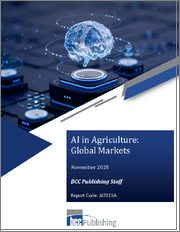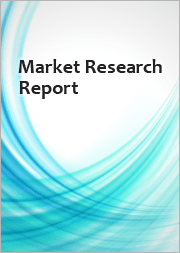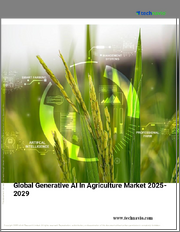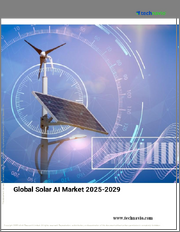
|
시장보고서
상품코드
1833591
지속가능한 농업 시장 예측(-2032년) : 농법, 투입 유형, 작물 유형, 농장 규모, 기술, 최종 사용자, 지역별 세계 분석Sustainable Agriculture Market Forecasts to 2032 - Global Analysis By Farming Practice, Input Type, Crop Type, Farm Size, Technology, End User and By Geography |
||||||
Stratistics MRC에 따르면 세계의 지속가능한 농업 시장은 2025년에 242억 달러를 차지하고 예측 기간 동안 CAGR은 11.6%를 나타내 2032년에는 522억 달러에 이를 것으로 전망됩니다.
지속가능한 농업 시장은 생산성과 환경 스튜어드십의 균형을 이루는 친환경 농법을 강조합니다. 토양의 건전성 관리, 윤작, 물 효율, 화학물질의 투입 삭감 등을 통합하여 장기적인 식량 안보를 실현합니다. 책임을 지고 생산된 식품에 대한 세계적인 수요가 높아지고, 정부의 지원 정책, 유기 비료와 정밀 농업에 있어서의 기술 혁신이 채용을 촉진하고 있습니다. 이 시장은 소비자가 추적성, 생물다양성 보전, 탄소 감축을 우선시함에 따라 확대되고 있습니다. 투자자와 이해관계자들 사이에서 지속가능한 농업은 탄력적이고 기후 변화를 고려한 식량시스템에 필수적이라는 견해가 강해지고 있습니다.
NITI Aayog 및 CSTEP에 따르면, 안드라프라데시 주에서 시행된 제로 예산 자연농법(ZBNF)은 물 사용량을 50-60%, 배출량을 55-99% 감소시켰으며, 경작 비용을 에이커당 3,000-2만 2,000루피 절감했습니다.
유기 제품에 대한 소비자 수요
시장은 주로 건강과 환경의 지속가능성에 대한 소비자 의식의 큰 변화에 의해 지원됩니다. 쇼핑객은 식품 라벨을 점점 더 음미하게 되고, 보다 건강하고 합성 화학물질을 사용하지 않는 것으로 보이는 유기 제품을 적극적으로 요구하고 있습니다. 이 동향은 더 이상 틈새 트렌드가 아니라 주류가되고 있으며, 주요 소매 업체와 식품 브랜드는 브랜드 자금을 지키기 위해 지속가능한 원재료를 조달해야 할 필요가 없습니다. 그 결과, 이 소비자의 견인력은 생산자에게 신뢰할 수 있는 성장하는 수익원이 되고, 보다 많은 농가들이 이 프리미엄 시장 부문을 획득하기 위해 지속가능한 관행으로의 이행을 촉구하게 됩니다.
리소스에 대한 액세스 제한
유기 인증으로의 전환과 정밀 농업 장비 구매를 위한 초기 투자는 많은 영세 농민들에게 엄청나게 높습니다. 게다가 기술연수와 조언서비스도 부족하기 때문에 농가는 새로운 관행을 효과적으로 실시할 수 있는지 불안을 겪고 있습니다. 이러한 자원의 격차는 지속가능한 방법으로부터 가장 혜택을 받는 입장에 있는 사람들이 마이그레이션을 시작할 준비를 가장 게을리하고 있다는 악순환을 만들어 시장 전체의 성장을 억제하고 있습니다.
농림업 통합
새로운 큰 기회는 나무와 관목을 작물과 가축과 결합하는 농업 숲의 전략적 통합에 있습니다. 이 시스템은 생물 다양성을 높이고 토양의 건전성을 향상시키고 대량의 탄소를 격리함으로써 다면적 솔루션을 제공합니다. 게다가 목재나 과일의 수확에 의해 농가에게 새로운 수입원을 가져오는 동시에, 농가의 핵심 사업을 기후 변화에 대해 더욱 강하게 합니다. 이 종합적인 접근법은 경제적 실행 가능성과 생태계에 대한 엄청난 혜택을 양립시키는 미래를 향한 강력한 모델입니다.
기후 변화
이 부문은 예측할 수 없는 강우, 긴 가뭄, 심각한 홍수 등 기후 변화 증가로 인한 직접적이고 심각한 위협에 직면하고 있습니다. 이러한 현상은 생산주기를 직접적으로 방해하고, 작물의 수율을 감소시키고, 수확을 파괴하고, 지속가능한 농업을 실천하는 농장의 경제적 안정을 손상시킬 수 있습니다. 이러한 변동은 장기적인 계획을 매우 어렵게 만들고 재무 위험이 너무 높다고 생각하는 신규 참가자의 발판이 됩니다. 이러한 끊임없는 압력은 시장의 안정성을 저해하고 기후 변화에 강한 농업 시스템으로의 전환을 지연시킬 수 있습니다.
COVID-19의 영향 :
유행은 당초 세계 공급망에 심각한 혼란을 일으켰고, 기존의 농업 모델의 취약성을 드러내고 노동력 부족을 일으켰습니다. 그러나 지속가능한 농업 부문은 기폭제가 되었습니다. 락다운은 소비자의 건강, 면역력, 식품 출처에 대한 관심을 높여 현지산 및 유기농산물에 대한 수요를 가속화했습니다. 이 위기는 탄력적이고 분산된 식량시스템의 중요한 필요성을 부각시키고, 미래의 세계적 충격에 대한 완충재로서 지속가능한 관행에 대한 투자와 정책지원을 촉구하고 결국 시장의 장기적 궤도를 강화했습니다.
예측기간 동안 유기농업 부문이 최대가 될 전망
유기농업분야는 확립된 소비자 수요와 프리미엄 가격 체계에 밀려 있으며 예측기간 동안 최대 시장 점유율을 차지할 것으로 예측됩니다. 이 분야는 견고한 인증 제도와 강력한 소매 파트너십에 힘입어 세계 동향에서 실질적인 산업으로 성숙해 왔습니다. 또한 일부 지역에서는 정부의 우대 조치로 관행 농지의 유기 재배로의 전환이 적극적으로 장려되어 시장의 지위를 확고하게 하고 있습니다. 이 분야의 규모와 일관된 소비자 충성도는 지속가능한 농업 시장 전체에 안정적인 기반을 제공하여 이 분야의 지속적인 리더십을 보장합니다.
예측기간 동안 바이오 농약·바이오제초제 분야가 가장 높은 CAGR을 나타낼 것으로 예측됩니다.
예측 기간 동안 생물 농약 및 바이오 제초제 분야는 효과적이고 환경 친화적인 해충 관리 솔루션에 대한 긴급한 요구에 견인되어 가장 높은 성장률을 나타낼 것으로 예측됩니다. 합성농약에 대한 규제가 엄격해지고 해충의 저항성이 높아지고 있기 때문에 생산자는 보다 안전한 대체품을 요구할 수밖에 없습니다. 게다가 이 제품들은 종합적 해충관리(IPM)와 유기농업 원칙에 완벽하게 부합하며 시너지 수요를 창출하고 있습니다. 높은 성장은 환경과 인간의 건강을 손상시키지 않으면 서 작물의 수율을 보호하는 적극적인 생물학적 솔루션으로 시장 변화를 반영합니다.
최대 점유율을 차지하는 지역 :
예측 기간 동안 북미는 높은 구매력과 지속가능한 식품 선택에 대한 강한 의식을 가진 정교한 소비자층을 배경으로 최대 시장 점유율을 차지할 것으로 예측됩니다. 이 지역은 첨단 농업 인프라, 농업 기술 기업에 의한 대규모 R&D 투자, 연방 정부 및 주 수준의 지원 프로그램으로부터 혜택을 누리고 있습니다. 게다가 유기농 프라이빗 라벨을 전개하는 대형 소매 체인이 존재함으로써 시장에의 침투와 접근의 용이성이 확보되고 있으며, 이 지역이 세계의 지속가능한 농업 전망에서 지배적인 지위를 확립하는 것은 당면의 과제입니다.
가장 높은 CAGR을 나타내는 지역 :
예측 기간 동안 아시아태평양이 가장 높은 CAGR을 나타낼 것으로 예측됩니다. 이것은 인구 증가와 환경 악화로 인해 농업 부문의 거대화가 점점 가속화되고 있음이 배경에 있습니다. 지속가능한 관행을 추진하기 위한 정부의 이니셔티브 증가와 식품안전문제에 대한 중간층의 의식 증가가 주요 성장 촉진요인이 되고 있습니다. 게다가 이 지역은 농부들이 수율과 토양의 건전성을 향상시키려고 하기 때문에 신기술의 채용에 큰 가능성을 보여주고 있으며, 향후 수년간 지속가능한 농업 시장의 급속한 확대를 위한 비옥한 토양을 만들어 내고 있습니다.
무료 사용자 정의 서비스 :
이 보고서를 구독하는 고객은 다음 무료 맞춤설정 옵션 중 하나를 사용할 수 있습니다.
- 기업 프로파일
- 추가 시장 기업의 종합적 프로파일링(3개사까지)
- 주요 기업의 SWOT 분석(3개사까지)
- 지역 세분화
- 고객의 관심에 응한 주요국 시장 추계·예측·CAGR(주 : 타당성 확인에 따름)
- 경쟁 벤치마킹
- 제품 포트폴리오, 지리적 존재, 전략적 제휴에 기반한 주요 기업 벤치마킹
목차
제1장 주요 요약
제2장 서문
- 개요
- 이해관계자
- 조사 범위
- 조사 방법
- 데이터 마이닝
- 데이터 분석
- 데이터 검증
- 조사 접근
- 조사 자료
- 1차 조사 자료
- 2차 조사 정보원
- 전제조건
제3장 시장 동향 분석
- 성장 촉진요인
- 성장 억제요인
- 기회
- 위협
- 기술 분석
- 최종 사용자 분석
- 신흥 시장
- COVID-19의 영향
제4장 Porter's Five Forces 분석
- 공급기업의 협상력
- 구매자의 협상력
- 대체품의 위협
- 신규 참가업체의 위협
- 경쟁 기업 간 경쟁 관계
제5장 세계의 지속가능한 농업 시장 : 농법별
- 유기농 농업
- 보전 경작
- 농림업
- 통합 해충 관리
- 퍼머컬처
- 작물 회전 및 덮개 작물 재배
제6장 세계의 지속가능한 농업 시장 : 투입 유형별
- 생물학적 비료 및 토양 개량제
- 유기농 종자 및 식재 재료
- 생물농약 및 생물제초제
- 관개 및 수자원 관리 시스템
제7장 세계의 지속가능한 농업 시장 : 작물 유형별
- 곡물 및 잡곡
- 과일 및 채소
- 지방종자 및 콩류
- 기타 작물 유형
제8장 세계의 지속가능한 농업 시장 : 농장 규모별
- 소규모 농장
- 중규모 농장
- 대규모 상업 농장
제9장 세계의 지속가능한 농업 시장 : 기술별
- 정밀 농업
- 통제 환경 농업
- 디지털 플랫폼 및 농장 관리 소프트웨어
- 신재생에너지 솔루션
제10장 세계의 지속가능한 농업 시장 : 최종 사용자별
- 농민 및 재배자
- 농업 협동조합
- 식음료 회사
- 정부 및 NGO
제11장 세계의 지속가능한 농업 시장 : 지역별
- 북미
- 미국
- 캐나다
- 멕시코
- 유럽
- 독일
- 영국
- 이탈리아
- 프랑스
- 스페인
- 기타 유럽
- 아시아태평양
- 일본
- 중국
- 인도
- 호주
- 뉴질랜드
- 한국
- 기타 아시아태평양
- 남미
- 아르헨티나
- 브라질
- 칠레
- 기타 남미
- 중동 및 아프리카
- 사우디아라비아
- 아랍에미리트(UAE)
- 카타르
- 남아프리카
- 기타 중동 및 아프리카
제12장 주요 발전
- 계약, 파트너십, 협업, 합작투자
- 인수와 합병
- 신제품 발매
- 사업 확대
- 기타 주요 전략
제13장 기업 프로파일링
- Bayer
- Corteva Agriscience
- Syngenta Group
- BASF Agricultural Solutions
- Yara International
- Nutrien
- Cargill
- Archer-Daniels-Midland(ADM)
- John Deere
- AGCO Corporation
- Trimble Inc.
- Indigo Ag
- Olam International
- Pivot Bio
- Netafim
- AeroFarms
- Plenty(Plenty Unlimited)
According to Stratistics MRC, the Global Sustainable Agriculture Market is accounted for $24.2 billion in 2025 and is expected to reach $52.2 billion by 2032 growing at a CAGR of 11.6% during the forecast period. The sustainable agriculture market emphasizes eco-friendly farming practices that balance productivity with environmental stewardship. It integrates soil health management, crop rotation, water efficiency, and reduced chemical inputs to achieve long-term food security. Rising global demand for responsibly produced food, supportive government policies, and technological innovations in organic fertilizers and precision farming are driving adoption. This market is expanding as consumers prioritize traceability, biodiversity preservation, and carbon reduction. Investors and stakeholders increasingly view sustainable agriculture as essential for resilient, climate-smart food systems.
According to NITI Aayog and CSTEP, Zero Budget Natural Farming (ZBNF) in Andhra Pradesh reduced water use by 50-60%, emissions by 55-99%, and cultivation costs by ₹3,000-₹22,000 per acre.
Market Dynamics:
Driver:
Consumer Demand for Organic Products
The market is primarily propelled by a profound shift in consumer consciousness towards health and environmental sustainability. Shoppers are increasingly scrutinizing food labels, actively seeking out organic products perceived as healthier and free from synthetic chemicals. This demand is no longer a niche trend but a mainstream movement, compelling major retailers and food brands to source sustainable ingredients to protect their brand equity. Consequently, this consumer pull creates a reliable and growing revenue stream for producers, encouraging more farmers to transition to sustainable practices to capture this premium market segment.
Restraint:
Limited Access to Resources
The initial investment for transitioning to organic certification or purchasing precision farming equipment is prohibitively high for many smallholder farmers. Furthermore, a lack of technical training and advisory services leaves farmers uncertain about implementing new practices effectively. This resource gap creates a vicious cycle, where those who stand to benefit most from sustainable methods are often the least equipped to initiate the transition, thereby restraining overall market growth.
Opportunity:
Integration of Agroforestry
A significant emerging opportunity lies in the strategic integration of agroforestry, which combines trees and shrubs with crops or livestock. This system offers a multifaceted solution by enhancing biodiversity, improving soil health, and sequestering significant amounts of carbon, thus opening up potential revenue from carbon credit markets. Moreover, it provides farmers with additional income streams from timber or fruit harvests while making their core operations more resilient to climate extremes. This holistic approach represents a powerful model for the future, aligning economic viability with profound ecological benefits.
Threat:
Climate Variability
The sector faces an immediate and escalating threat from increasing climate variability, including unpredictable rainfall, prolonged droughts, and severe flooding. These events directly disrupt production cycles, reduce crop yields, and can decimate harvests, undermining the economic stability of farms committed to sustainable practices. Such volatility makes long-term planning exceedingly difficult and can deter new entrants who perceive the financial risks as too high. This constant pressure threatens to erode market stability and can slow down the transition to more climate-resilient agricultural systems.
Covid-19 Impact:
The pandemic initially triggered severe disruptions in global supply chains, exposing the fragility of conventional agricultural models and causing labor shortages. However, it also acted as a catalyst for the sustainable agriculture sector. Lockdowns heightened consumer focus on health, immunity, and food provenance, accelerating demand for locally sourced and organic produce. This crisis underscored the critical need for resilient and decentralized food systems, prompting increased investment and policy support for sustainable practices as a buffer against future global shocks, ultimately strengthening the market's long-term trajectory
The organic farming segment is expected to be the largest during the forecast period
The organic farming segment is expected to account for the largest market share during the forecast period fueled by well-established consumer demand and premium pricing structures. This segment has matured beyond a trend into a substantial global industry, supported by robust certification systems and strong retail partnerships. Furthermore, government incentives in several regions actively encourage the conversion of conventional farmland to organic, solidifying its market position. The segment's scale and consistent consumer loyalty provide a stable foundation for the entire sustainable agriculture market, ensuring its continued leadership.
The biopesticides & bioherbicides segment is expected to have the highest CAGR during the forecast period
Over the forecast period, the biopesticides & bioherbicides segment is predicted to witness the highest growth rate driven by the urgent need for effective, eco-friendly pest management solutions. Stricter regulations on synthetic pesticides and rising resistance among pest populations are compelling growers to seek safer alternatives. Additionally, these products align perfectly with the principles of integrated pest management (IPM) and organic farming, creating synergistic demand. The high growth reflects a market shift towards targeted, biological solutions that protect crop yields without compromising environmental or human health.
Region with largest share:
During the forecast period, the North America region is expected to hold the largest market share anchored by a sophisticated consumer base with high purchasing power and a strong awareness of sustainable food choices. The region benefits from advanced agricultural infrastructure, significant R&D investments from agri-tech corporations, and supportive federal and state-level programs. Moreover, the presence of major retail chains with dedicated organic private-label lines ensures widespread market penetration and accessibility, cementing the region's dominant position in the global sustainable agriculture landscape for the foreseeable future.
Region with highest CAGR:
Over the forecast period, the Asia Pacific region is anticipated to exhibit the highest CAGR fueled by a massive agricultural sector increasingly pressured by population growth and environmental degradation. Rising governmental initiatives to promote sustainable practices, coupled with growing middle-class awareness of food safety issues, are key drivers. Furthermore, the region presents immense potential for the adoption of novel technologies, as farmers seek to improve yields and soil health, creating a fertile ground for the rapid expansion of the sustainable agriculture market in the coming years.
Key players in the market
Some of the key players in Sustainable Agriculture Market include Bayer, Corteva Agriscience, Syngenta Group, BASF Agricultural Solutions, Yara International, Nutrien, Cargill, Archer-Daniels-Midland (ADM), John Deere, AGCO Corporation, Trimble Inc., Indigo Ag, Olam International, Pivot Bio, Netafim, AeroFarms, and Plenty.
Key Developments:
In July 2025, Cargill supports regenerative agriculture by connecting farmers to environmental markets through its RegenConnect(R) program, providing incentives and agronomic support. They collaborate with PepsiCo to expand regenerative practices across 240,000 acres in Iowa by 2030.
In October 2024, ADM has enrolled over 260 UK farmers in its regenerative agriculture program and aims for 5 million acres globally by 2025. They partner with Smucker and other organizations to expand regenerative practices in the U.S. peanut value chain and reduce carbon footprints.
In May 2023, Nutrien partnered with Bunge to create a sustainable agriculture network supporting U.S. farmers with practices like cover cropping and nutrient management to reduce carbon footprints. Nutrien also joined U.S. Farmers and Ranchers in Action (USFRA) to promote sustainable outcomes in farming.
Farming Practices Covered:
- Organic Farming
- Conservation Tillage
- Agroforestry
- Integrated Pest Management
- Permaculture
- Crop Rotation & Cover Cropping
Input Types Covered:
- Biological Fertilizers & Soil Amendments
- Organic Seeds & Planting Material
- Biopesticides & Bioherbicides
- Irrigation & Water Management Systems
Crop Types Covered:
- Cereals & Grains
- Fruits & Vegetables
- Oilseeds & Pulses
- Other Specialty Crops
Farm Sizes Covered:
- Smallholder Farms
- Medium Farms
- Large Commercial Farms
Technologies Covered:
- Precision Agriculture
- Controlled Environment Agriculture
- Digital Platforms & Farm Management Software
- Renewable Energy Solutions
End Users Covered:
- Farmers & Growers
- Agri-Cooperatives
- Food & Beverage Companies
- Government & NGOs
Regions Covered:
- North America
- US
- Canada
- Mexico
- Europe
- Germany
- UK
- Italy
- France
- Spain
- Rest of Europe
- Asia Pacific
- Japan
- China
- India
- Australia
- New Zealand
- South Korea
- Rest of Asia Pacific
- South America
- Argentina
- Brazil
- Chile
- Rest of South America
- Middle East & Africa
- Saudi Arabia
- UAE
- Qatar
- South Africa
- Rest of Middle East & Africa
What our report offers:
- Market share assessments for the regional and country-level segments
- Strategic recommendations for the new entrants
- Covers Market data for the years 2024, 2025, 2026, 2028, and 2032
- Market Trends (Drivers, Constraints, Opportunities, Threats, Challenges, Investment Opportunities, and recommendations)
- Strategic recommendations in key business segments based on the market estimations
- Competitive landscaping mapping the key common trends
- Company profiling with detailed strategies, financials, and recent developments
- Supply chain trends mapping the latest technological advancements
Free Customization Offerings:
All the customers of this report will be entitled to receive one of the following free customization options:
- Company Profiling
- Comprehensive profiling of additional market players (up to 3)
- SWOT Analysis of key players (up to 3)
- Regional Segmentation
- Market estimations, Forecasts and CAGR of any prominent country as per the client's interest (Note: Depends on feasibility check)
- Competitive Benchmarking
- Benchmarking of key players based on product portfolio, geographical presence, and strategic alliances
Table of Contents
1 Executive Summary
2 Preface
- 2.1 Abstract
- 2.2 Stake Holders
- 2.3 Research Scope
- 2.4 Research Methodology
- 2.4.1 Data Mining
- 2.4.2 Data Analysis
- 2.4.3 Data Validation
- 2.4.4 Research Approach
- 2.5 Research Sources
- 2.5.1 Primary Research Sources
- 2.5.2 Secondary Research Sources
- 2.5.3 Assumptions
3 Market Trend Analysis
- 3.1 Introduction
- 3.2 Drivers
- 3.3 Restraints
- 3.4 Opportunities
- 3.5 Threats
- 3.6 Technology Analysis
- 3.7 End User Analysis
- 3.8 Emerging Markets
- 3.9 Impact of Covid-19
4 Porters Five Force Analysis
- 4.1 Bargaining power of suppliers
- 4.2 Bargaining power of buyers
- 4.3 Threat of substitutes
- 4.4 Threat of new entrants
- 4.5 Competitive rivalry
5 Global Sustainable Agriculture Market, By Farming Practice
- 5.1 Introduction
- 5.2 Organic Farming
- 5.3 Conservation Tillage
- 5.4 Agroforestry
- 5.5 Integrated Pest Management
- 5.6 Permaculture
- 5.7 Crop Rotation & Cover Cropping
6 Global Sustainable Agriculture Market, By Input Type
- 6.1 Introduction
- 6.2 Biological Fertilizers & Soil Amendments
- 6.3 Organic Seeds & Planting Material
- 6.4 Biopesticides & Bioherbicides
- 6.5 Irrigation & Water Management Systems
7 Global Sustainable Agriculture Market, By Crop Type
- 7.1 Introduction
- 7.2 Cereals & Grains
- 7.3 Fruits & Vegetables
- 7.4 Oilseeds & Pulses
- 7.5 Other Specialty Crops
8 Global Sustainable Agriculture Market, By Farm Size
- 8.1 Introduction
- 8.2 Smallholder Farms
- 8.3 Medium Farms
- 8.4 Large Commercial Farms
9 Global Sustainable Agriculture Market, By Technology
- 9.1 Introduction
- 9.2 Precision Agriculture
- 9.3 Controlled Environment Agriculture
- 9.4 Digital Platforms & Farm Management Software
- 9.5 Renewable Energy Solutions
10 Global Sustainable Agriculture Market, By End User
- 10.1 Introduction
- 10.2 Farmers & Growers
- 10.3 Agri-Cooperatives
- 10.4 Food & Beverage Companies
- 10.5 Government & NGOs
11 Global Sustainable Agriculture Market, By Geography
- 11.1 Introduction
- 11.2 North America
- 11.2.1 US
- 11.2.2 Canada
- 11.2.3 Mexico
- 11.3 Europe
- 11.3.1 Germany
- 11.3.2 UK
- 11.3.3 Italy
- 11.3.4 France
- 11.3.5 Spain
- 11.3.6 Rest of Europe
- 11.4 Asia Pacific
- 11.4.1 Japan
- 11.4.2 China
- 11.4.3 India
- 11.4.4 Australia
- 11.4.5 New Zealand
- 11.4.6 South Korea
- 11.4.7 Rest of Asia Pacific
- 11.5 South America
- 11.5.1 Argentina
- 11.5.2 Brazil
- 11.5.3 Chile
- 11.5.4 Rest of South America
- 11.6 Middle East & Africa
- 11.6.1 Saudi Arabia
- 11.6.2 UAE
- 11.6.3 Qatar
- 11.6.4 South Africa
- 11.6.5 Rest of Middle East & Africa
12 Key Developments
- 12.1 Agreements, Partnerships, Collaborations and Joint Ventures
- 12.2 Acquisitions & Mergers
- 12.3 New Product Launch
- 12.4 Expansions
- 12.5 Other Key Strategies
13 Company Profiling
- 13.1 Bayer
- 13.2 Corteva Agriscience
- 13.3 Syngenta Group
- 13.4 BASF Agricultural Solutions
- 13.5 Yara International
- 13.6 Nutrien
- 13.7 Cargill
- 13.8 Archer-Daniels-Midland (ADM)
- 13.9 John Deere
- 13.10 AGCO Corporation
- 13.11 Trimble Inc.
- 13.12 Indigo Ag
- 13.13 Olam International
- 13.14 Pivot Bio
- 13.15 Netafim
- 13.16 AeroFarms
- 13.17 Plenty (Plenty Unlimited)






